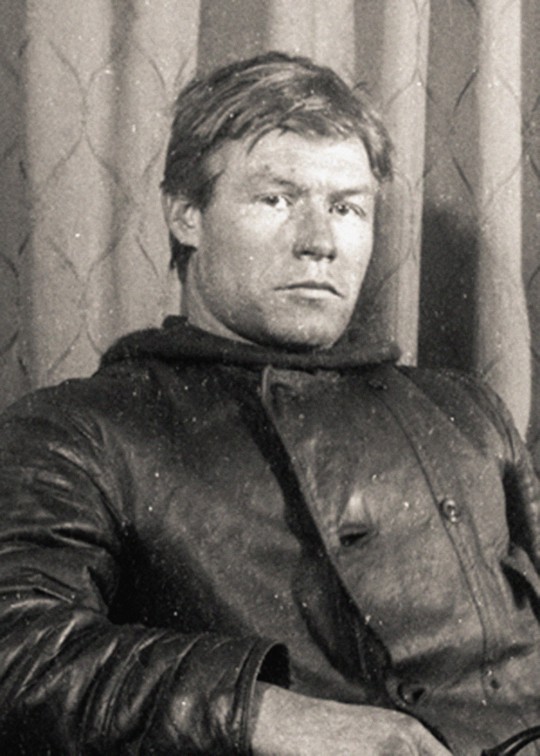Explorers
Knudsen, Paul (1889-1919)
Knudsen participated on Roald Amundsen’s Maud expedition with the main job of assisting Knut Sundbeck in the engine room.

Paul Knudsen was born in Reinfjord in Sømna (county of Nordland) 3 March 1889 as the oldest of five children. Sømna is the neighbour municipality to Bindal, where Otto Sverdrup was born, and when Sverdrup was asked to lead an expedition with the Eclipse 1914-15 to search for a Russian expedition that had disappeared in the Northeast Passage, Knudsen was asked to join.
After the first winter at Maudheim by Mys Chelyuskina (Cape Chelyuskin), one of the other crew members, Tessem, wished to leave the expedition, apparently owing to bouts of headaches and sleeplessness. Paul Knudsen volunteered to go with him back to the telegraph station on Dickson Island, taking with them post and the expedition’s scientific data so far. The two left Maudheim by dog sledge on 15 October 1919. The journey was 800 km long and most of the route had already been traversed by an earlier expedition; a month was therefore calculated for the trip. However, the two never arrived.
In March 1920 Amundsen’s brother Leon realized that the two were missing after he received a telegram from Amundsen who was then wintering with the Maud by Ajon Island. Otto Sverdrup organised a search expedition with the Heimen, but that was stopped by ice near to the peninsula Poluostrov Mikhaylova. In spring 1921 a Soviet-Norwegian search expedition led by Nikifor Begichev searched along the coast and at Mys Vil’da they found a message from Tessem and Knudsen in a cairn that Otto Sverdrup had built in 1915. This stated that all was well with the two so far. On the way west from there towards Dikson, Begichev found near Poluostrov Mikhaylova the remains of an open fire with burned bones, nails, buttons, remains of a pocket barometer, ammunition from 1912, and more. It was presumed that one of the men had perished and the other had burned the corpse since it was not possible to bury it in the frozen ground. It was later realized that these remains were from Vladimir Rusanov’s expedition that had disappeared in 1912 – including Alexander Kutschin from Amundsen’s Antarctic expedition – and that the bones were not human.
In 1922 a Soviet geological expedition led by N. N. Urvantsev found the post, the scientific data and other artefacts that had belonged to Knudsen and Tessem by the Zeledeev River, 80 km from Dikson. They had been stored in a depot, but no explanatory message was found. Nearer to Dikson, by the Uboynaya River, two pairs of Norwegian skis and part of a sleeping bag were found. Finally the skeleton of a man was found on a small slope by the sound that separates Dickson Island from the mainland. It was 3 km over the water to the telegraph station on the island and the man would have been able to see the lights there before he died. A gold watch engraved with Tessem’s name and a gold ring engraved with the name of his wife were found on the corpse. It was presumed that Tessem in that case had almost reached his goal when he slipped on the way down the slope, knocked himself out and froze to death.
Tessem’s remains were buried on top of the slope, which is now by Dickson town, and an impressive memorial stone was erected over the grave. A long discussion was carried out in the 1970s and ’80s between Soviet and Norwegian scientists as to whether the corpse was in fact Tessem’s, or maybe Knudsen’s, and that Knudsen had taken Tessem’s watch and ring with him after Tessem died. It is more or less concluded that the corpse was in fact Tessem.
Reference:
William Barr: The Last Journey of Peter Tessem and Paul Knutsen, 1919. In: Arctic, Vol. 36, No. 4 (December 1983) p. 311-327.
Unni Aas Sandholm og Kjell Reinfjord: Polfarer Paul Knutsen – hans liv og mystiske forsvinning.
- Expeditions
- Vessels
- Explorers
- Nansen, Fridtjof (1861-1930)
- Sverdrup, Otto Neumann Knoph (1854-1930)
- Amundsen, Roald (1872-1928)
- Amundsen, Anton (1853-1909)
- Balto, Samuel Johannesen (1861-1921)
- Baumann, Hans Adolf Viktor (1870-1932)
- Bay, Edvard (1867-1932)
- Beck, Andreas (1864-1914)
- Bentsen, Bernt (1860-1899)
- Bjaaland, Olav Olavsen (1873-1961)
- Blessing, Henrik Greve (1866-1918)
- Braskerud, Ove (1872-1899)
- Dahl, Odd (1898-1994)
- Dietrichson, Leif Ragnar (1890-1928)
- Dietrichson, Oluf (1856-1942)
- Doxrud, Christian (1881-1935)
- Ellsworth, Lincoln (1880-1951)
- Feucht, Karl (1893 – 1954)
- Fosheim, Ivar (1863-1944)
- Gjertsen, Hjalmar Fredrik (1885-1958)
- Gottwaldt, Birger Lund (1880-1968)
- Hansen, Godfred (1876-1937)
- Hansen, Ludvig Anton (1871-1955)
- Hanssen, Helmer Julius (1870-1956)
- Hassel, Sverre Helge (1876-1928)
- Hendriksen, Peder Leonard (1859-1932)
- Horgen, Emil Andreas (1889–1954)
- Isachsen, Gunnar (Gunnerius Ingvald) (1868-1939)
- Jacobsen, Theodor Claudius (1855-1933)
- Johansen, Fredrik Hjalmar (1867-1913)
- Juell, Adolf (1860-1909)
- Kakot
- Knudsen, Paul (1889-1919)
- Kristensen, Halvardus (1879 – 1919)
- Kristian Kristiansen (1865-1943)
- Kutschin, Alexander Stepanovich (1888 -1912)
- Lindstrøm, Adolf Henrik (1866-1939)
- Lund, Anton (1864–1945)
- Malmgren, Finn (1895-1928)
- Mogstad, Ivar Otto Irgens (1856-1928)
- Nilsen, Thorvald (1881-1940)
- Nordahl, Bernhard (1862-1922)
- Nødtvedt, Jacob (1857-1918)
- Olonkin, Gennadij (1898-1960)
- Olsen, Karenius (1890-1973)
- Olsen, Karl (1866-1939)
- Omdal, Oscar (1895-1927)
- Petterson, Lars (1860-1898)
- Prestrud, Kristian (1881-1927)
- Raanes, Oluf (1865-1932)
- Ramm, Fredrik (1892-1943)
- Ravna, Ole Nilsen (1841-1906)
- Riiser-Larsen, Hjalmar (1890–1965)
- Ristvedt, Peder (1873 – 1955)
- Rønne, Martin (1861-1932)
- Schei, Per (Peder Elisæus) (1875-1905)
- Schröer, Adolf Hermann (1872-1932)
- Scott Hansen, Sigurd (1868-1937)
- Simmons, Herman Georg (1866-1943)
- Stolz, Rudolf (1872- ??)
- Storm-Johnsen, Fridtjof (?-?)
- Stubberud, Jørgen (1883-1980)
- Sundbeck, Knut (1883 – 1967)
- Svendsen, Johan (1866-1899)
- Sverdrup, Harald Ulrik (1888-1957)
- Syvertsen, Søren Marentius (?? – 1923)
- Tessem, Peter Lorents (1875-1919)
- Tønnesen, Emanuel (1893–1972)
- Wiik, Gustav Juel (1878–1906)
- Wisting, Oscar (1871-1936)


